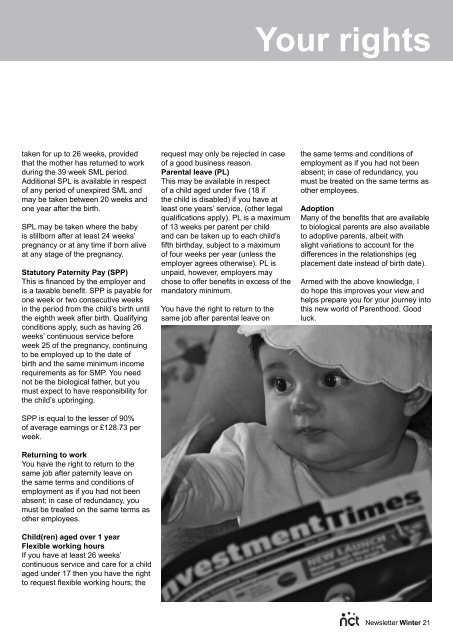Autumn 2011 - Mandy Mazliah
Autumn 2011 - Mandy Mazliah
Autumn 2011 - Mandy Mazliah
You also want an ePaper? Increase the reach of your titles
YUMPU automatically turns print PDFs into web optimized ePapers that Google loves.
Your rights<br />
taken for up to 26 weeks, provided<br />
that the mother has returned to work<br />
during the 39 week SML period.<br />
Additional SPL is available in respect<br />
of any period of unexpired SML and<br />
may be taken between 20 weeks and<br />
one year after the birth.<br />
SPL may be taken where the baby<br />
is stillborn after at least 24 weeks’<br />
pregnancy or at any time if born alive<br />
at any stage of the pregnancy.<br />
Statutory Paternity Pay (SPP)<br />
This is financed by the employer and<br />
is a taxable benefit. SPP is payable for<br />
one week or two consecutive weeks<br />
in the period from the child’s birth until<br />
the eighth week after birth. Qualifying<br />
conditions apply, such as having 26<br />
weeks’ continuous service before<br />
week 25 of the pregnancy, continuing<br />
to be employed up to the date of<br />
birth and the same minimum income<br />
requirements as for SMP. You need<br />
not be the biological father, but you<br />
must expect to have responsibility for<br />
the child’s upbringing.<br />
SPP is equal to the lesser of 90%<br />
of average earnings or £128.73 per<br />
week.<br />
Returning to work<br />
You have the right to return to the<br />
same job after paternity leave on<br />
the same terms and conditions of<br />
employment as if you had not been<br />
absent; in case of redundancy, you<br />
must be treated on the same terms as<br />
other employees.<br />
Child(ren) aged over 1 year<br />
Flexible working hours<br />
If you have at least 26 weeks’<br />
continuous service and care for a child<br />
aged under 17 then you have the right<br />
to request flexible working hours; the<br />
request may only be rejected in case<br />
of a good business reason.<br />
Parental leave (PL)<br />
This may be available in respect<br />
of a child aged under five (18 if<br />
the child is disabled) if you have at<br />
least one years’ service, (other legal<br />
qualifications apply). PL is a maximum<br />
of 13 weeks per parent per child<br />
and can be taken up to each child’s<br />
fifth birthday, subject to a maximum<br />
of four weeks per year (unless the<br />
employer agrees otherwise). PL is<br />
unpaid, however, employers may<br />
chose to offer benefits in excess of the<br />
mandatory minimum.<br />
You have the right to return to the<br />
same job after parental leave on<br />
the same terms and conditions of<br />
employment as if you had not been<br />
absent; in case of redundancy, you<br />
must be treated on the same terms as<br />
other employees.<br />
Adoption<br />
Many of the benefits that are available<br />
to biological parents are also available<br />
to adoptive parents, albeit with<br />
slight variations to account for the<br />
differences in the relationships (eg<br />
placement date instead of birth date).<br />
Armed with the above knowledge, I<br />
do hope this improves your view and<br />
helps prepare you for your journey into<br />
this new world of Parenthood. Good<br />
luck.<br />
Newsletter Winter 21





